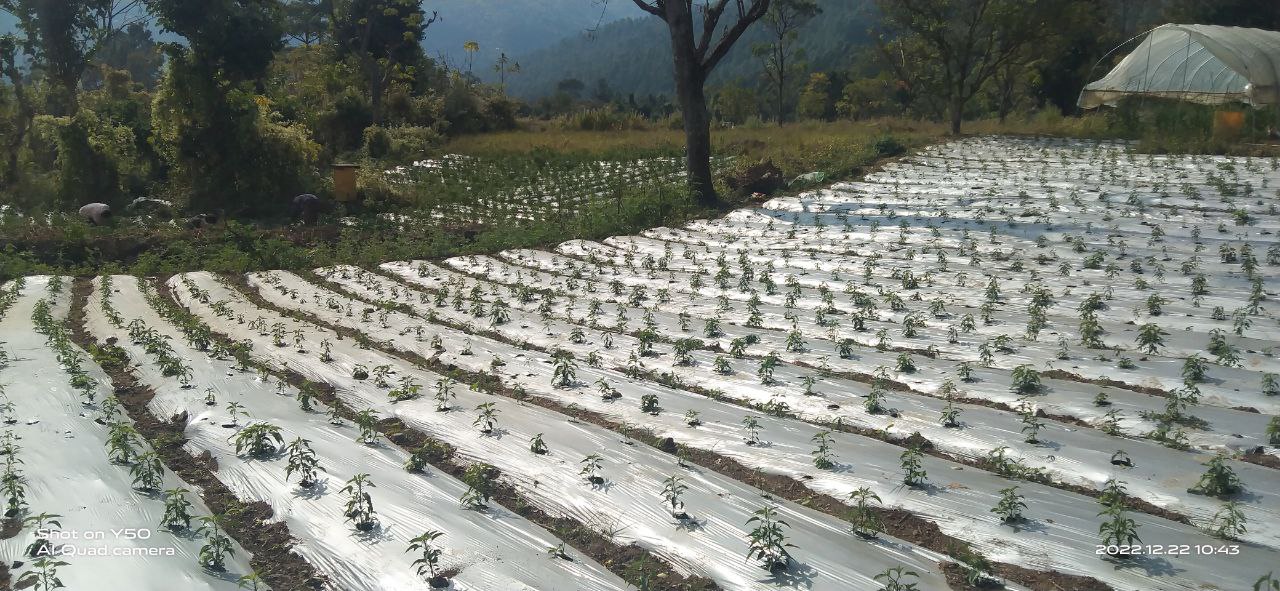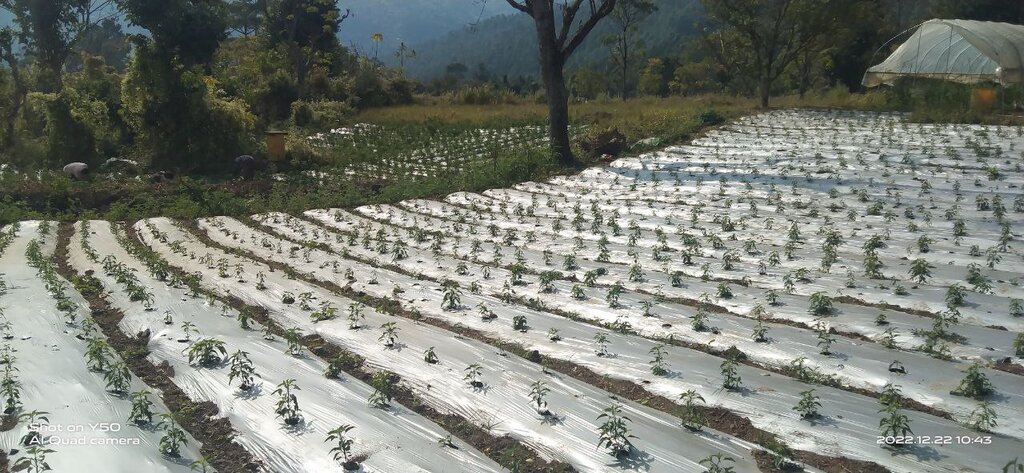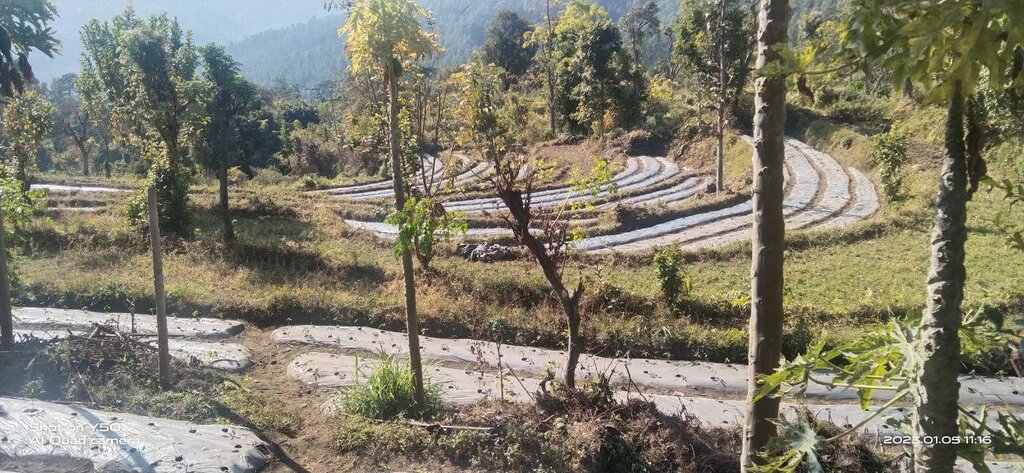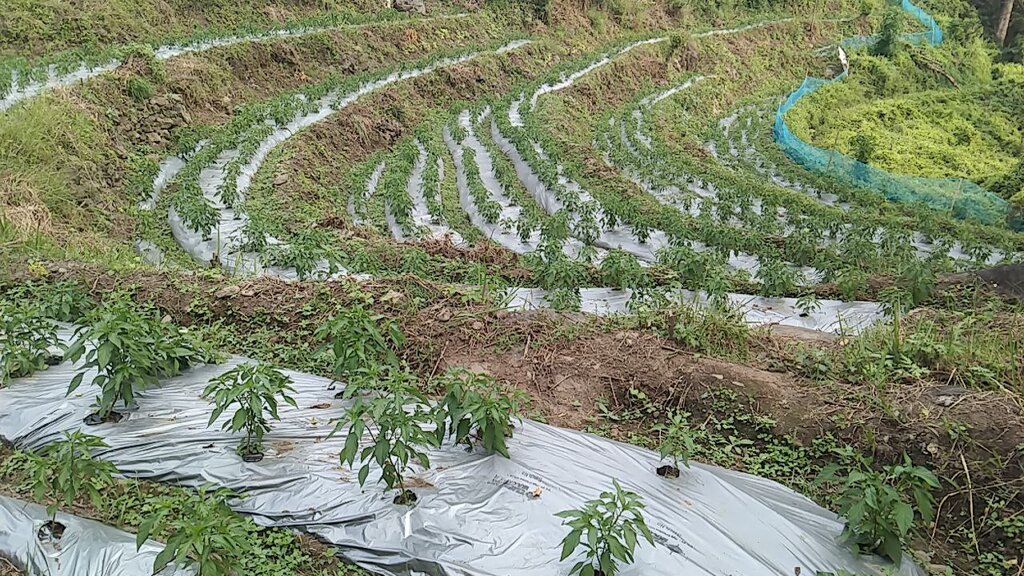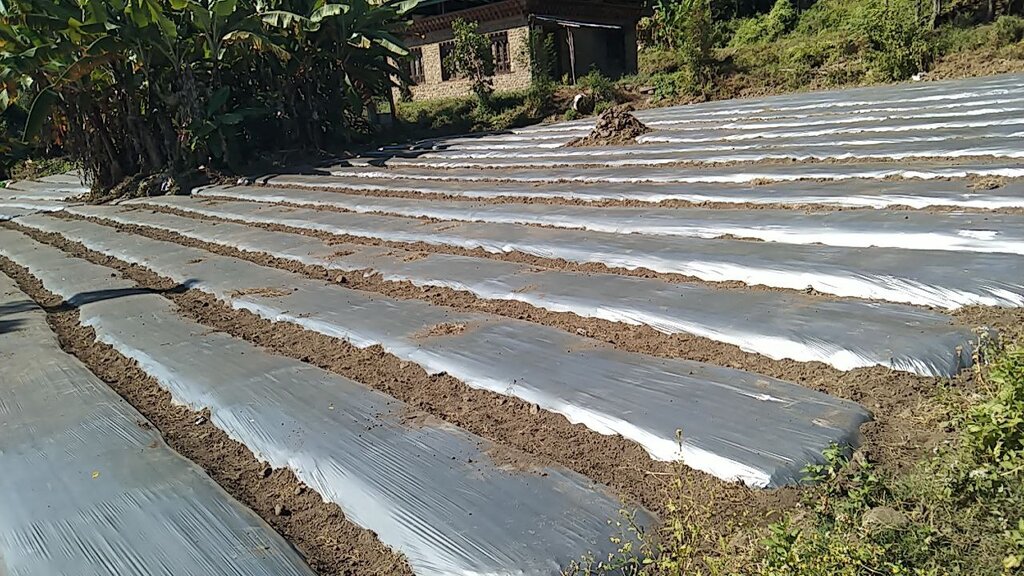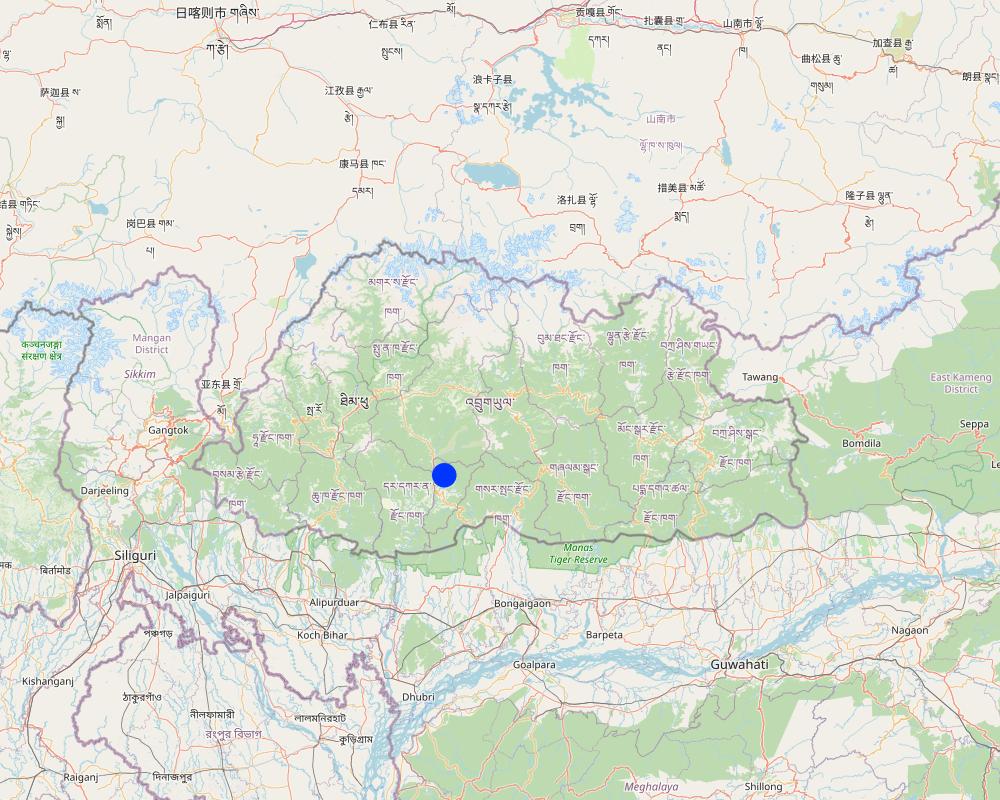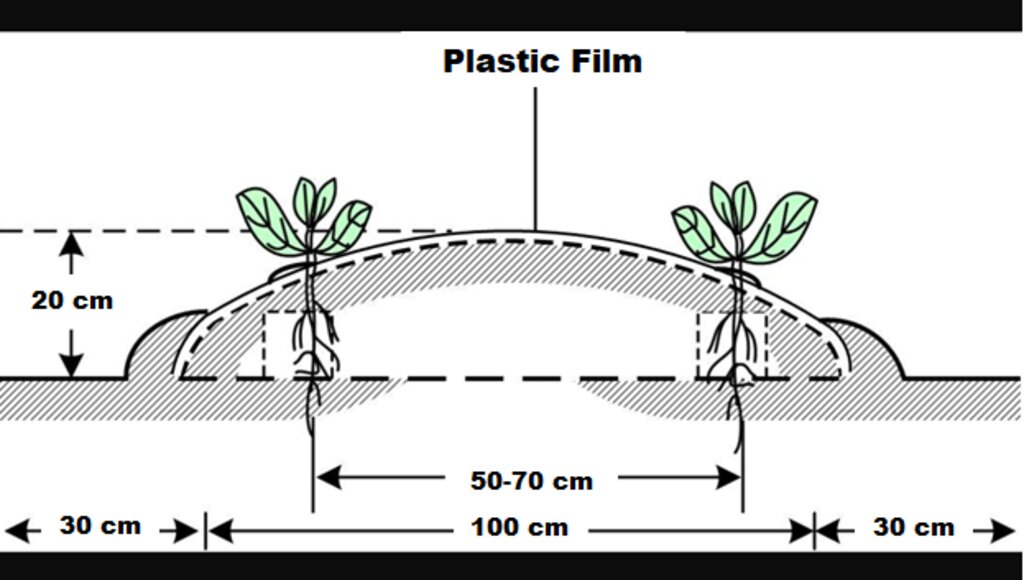Plastic mulching for cash crops [Bhutan]
- Creation:
- Update:
- Compiler: Tshering Yangzom
- Editor: Kuenzang Nima
- Reviewers: William Critchley, Rima Mekdaschi Studer, Joana Eichenberger
Nyuel Thok Nang Chhu Sho Thing Ni (དངུལ་ཐོག་ནང་ཆུ་ཤོག་ཐིང་ནི།)
technologies_6864 - Bhutan
View sections
Expand all Collapse all1. General information
1.2 Contact details of resource persons and institutions involved in the assessment and documentation of the Technology
Key resource person(s)
land user:
Rai Pratap Singh
Bhutan
Name of project which facilitated the documentation/ evaluation of the Technology (if relevant)
Strengthening national-level institutional and professional capacities of country Parties towards enhanced UNCCD monitoring and reporting – GEF 7 EA Umbrella II (GEF 7 UNCCD Enabling Activities_Umbrella II)Name of the institution(s) which facilitated the documentation/ evaluation of the Technology (if relevant)
National Soil Services Center, Department of Agric (National Soil Services Center, Department of Agric) - Bhutan1.3 Conditions regarding the use of data documented through WOCAT
The compiler and key resource person(s) accept the conditions regarding the use of data documented through WOCAT:
Yes
1.4 Declaration on sustainability of the described Technology
Is the Technology described here problematic with regard to land degradation, so that it cannot be declared a sustainable land management technology?
No
Comments:
Mulching in agriculture helps conserve moisture, prevent water and wind erosion, control weeds, and regulate soil temperature. While it has these benefits, it also poses environmental concerns related to soil contamination and waste accumulation. Plastic mulches are a significant source of microplastic pollution in agricultural soils. The residual microplastics in the soil negatively affect soil health. Used plastic mulches are eventually burned and the burning releases greenhouse gases, contributing to climate change and global warming. Additionally, the residues left behind after burning plastic mulches can persist in the soil for extended periods thereby contaminating the soil. Though mulching helps increase crop yields, it has negative effects on the natural environment and thus the use of mulching necessitates careful consideration.
2. Description of the SLM Technology
2.1 Short description of the Technology
Definition of the Technology:
Plastic mulching comprises thin plastic sheets laid out on raised soil surfaces around plants to help conserve soil moisture, prevent water and wind erosion, control weeds, and regulate soil temperature. It is used in agriculture to increase crop yields. However, there are environmental concerns about soil contamination and waste disposal.
2.2 Detailed description of the Technology
Description:
Plastic mulching is a widely used agricultural practice in Bhutan, primarily employed in the cultivation of cash crops. Farmers have adopted plastic mulching to enhance crop production and address specific agricultural challenges. It allows farmers to optimize water usage by reducing evaporation and maintaining soil moisture levels, which is crucial in regions where water resources are limited. It also helps suppress weed growth, minimizing competition for nutrients and ensuring healthier crop growth. Additionally, the regulation of soil temperature through plastic mulching can extend the growing season and improve crop quality and yields. These benefits are particularly valuable in Bhutan's mountainous terrain and varied climatic conditions.
However, the application of plastic mulching can have both direct and indirect impacts on the natural environment. Improper disposal or management of plastic mulch can lead to environmental pollution, including soil contamination and plastic waste accumulation. Therefore, sustainable practices and appropriate waste management techniques are crucial to minimize the potential negative effects on the natural environment.
Plastic mulching serves several purposes and functions in agricultural practices. One of its primary functions is moisture conservation, as it helps prevent water evaporation from the soil surface by acting as a barrier. Additionally, plastic mulch controls weeds by blocking sunlight and inhibiting weed seed germination, reducing competition for nutrients. Another important function is soil temperature regulation, as plastic mulching traps heat from the sun, raising soil temperatures in cooler climates and promoting faster plant growth. Overall, plastic mulch contributes to enhanced crop performance.
Furthermore, it helps prevent soil erosion by protecting the soil surface from wind and water erosion, thus maintaining soil structure and fertility, and creating a barrier between plants and the soil, reducing the risk of soil-borne pests and diseases affecting the crops. It can also deter certain pests by disrupting their habitat and limiting access to plants.
Plastic mulching involves the use of thin sheets or films made of polyethylene or similar materials, which come in various colours and thicknesses. Manual tools are utilized to lay the sheets evenly over the prepared soil. Before laying the plastic mulch, the soil is typically ploughed, levelled, raised, and cleared of debris to create a smooth surface. To prevent displacement by wind or other factors, the plastic mulch needs to be securely anchored to the ground. Plastic mulching can be combined with drip irrigation systems to provide water and nutrients directly to the plant roots.
Some specific advantages pointed out by the land user include the opportunity to achieve higher returns on agricultural investments. It reduces the need for manual weeding or herbicide application, saving time, labour, and resources. Additionally, it reduces the frequency of irrigation. It also extends the growing season expanding options and potential profits. There are many advantages of mulching but there are some serious disadvantages of the technology. Plastic mulching poses environmental concerns related to soil contamination and waste accumulation. Plastic mulches are a significant source of microplastic pollution in agricultural soils and these microplastics negatively affect soil health. The disposal of plastic mulches is a challenge as recycling options are limited resulting in waste accumulation on farms. These accumulated wastes are eventually burned and release greenhouse gases, contributing to climate change and global warming. Additionally, the residues left behind after burning plastic mulches can persist in the soil for extended periods thereby contaminating the soil. Also, the cost of purchasing plastic mulch can prove to be too high for farmers if the land area is huge. Though mulching helps increase crop yields, it has negative effects on the natural environment - thus the use of mulching necessitates careful consideration.
2.3 Photos of the Technology
2.5 Country/ region/ locations where the Technology has been applied and which are covered by this assessment
Country:
Bhutan
Region/ State/ Province:
Sergithang, Tsirang
Specify the spread of the Technology:
- evenly spread over an area
If precise area is not known, indicate approximate area covered:
- < 0.1 km2 (10 ha)
Is/are the technology site(s) located in a permanently protected area?
No
Comments:
The land user uses plastic mulching on 1 acre of land for chili production.
Map
×2.6 Date of implementation
Indicate year of implementation:
2018
2.7 Introduction of the Technology
- It was introduced by the gewog Agriculture Extension Officer and through exposure to social media.
3. Classification of the SLM Technology
3.1 Main purpose(s) of the Technology
- improve production
- create beneficial economic impact
3.2 Current land use type(s) where the Technology is applied
Land use mixed within the same land unit:
Yes
Specify mixed land use (crops/ grazing/ trees):
- Agroforestry

Cropland
- Annual cropping
- Tree and shrub cropping
Annual cropping - Specify crops:
- cereals - maize
- cereals - rice (wetland)
- root/tuber crops - potatoes
- vegetables - leafy vegetables (salads, cabbage, spinach, other)
- vegetables - melon, pumpkin, squash or gourd
- vegetables - root vegetables (carrots, onions, beet, other)
Tree and shrub cropping - Specify crops:
- avocado
- fruits, other
- mango, mangosteen, guava
Number of growing seasons per year:
- 2
Is intercropping practiced?
Yes
If yes, specify which crops are intercropped:
Vegetable crops are intercropped for self-consumption.
Is crop rotation practiced?
Yes
If yes, specify:
Vegetable crops are rotated.

Forest/ woodlands
- (Semi-)natural forests/ woodlands
Are the trees specified above deciduous or evergreen?
- mixed deciduous/ evergreen
Products and services:
- Fuelwood
3.3 Has land use changed due to the implementation of the Technology?
Has land use changed due to the implementation of the Technology?
- No (Continue with question 3.4)
3.4 Water supply
Water supply for the land on which the Technology is applied:
- mixed rainfed-irrigated
Comments:
The land users of Sergithang face water shortage problems.
3.5 SLM group to which the Technology belongs
- Weed management
3.6 SLM measures comprising the Technology

other measures
Specify:
Plastic mulching may fall under structural measures.
3.7 Main types of land degradation addressed by the Technology

soil erosion by water
- Wt: loss of topsoil/ surface erosion

soil erosion by wind
- Et: loss of topsoil

biological degradation
- Bp: increase of pests/ diseases, loss of predators

water degradation
- Ha: aridification
- Hs: change in quantity of surface water
3.8 Prevention, reduction, or restoration of land degradation
Specify the goal of the Technology with regard to land degradation:
- prevent land degradation
- reduce land degradation
Comments:
Plastic mulching prevents soil and water erosion and conserves soil mositure.
4. Technical specifications, implementation activities, inputs, and costs
4.1 Technical drawing of the Technology
Technical specifications (related to technical drawing):
This diagram shows a cross-section of a raised bed using plastic mulching. The plants grow through the punctured holes in the plastic. The length of the bed varies from farm to farm and is 1 m wide and spaced 30 cm apart (bed-bed spacing) for easy access/movement. The bed is usually raised to 20 cm in height. The planting distance shown in the diagram is for chilies, 50-70 cm. The distances will vary according to the crop/variety.
Author:
Thinley Penjor Dorji
Date:
20/07/2023
4.2 General information regarding the calculation of inputs and costs
Specify how costs and inputs were calculated:
- per Technology area
Indicate size and area unit:
1 acre
other/ national currency (specify):
Ngultrum
If relevant, indicate exchange rate from USD to local currency (e.g. 1 USD = 79.9 Brazilian Real): 1 USD =:
82.1
Indicate average wage cost of hired labour per day:
Nu 400
4.3 Establishment activities
| Activity | Timing (season) | |
|---|---|---|
| 1. | Field preparation (tilling) | Winter |
| 2. | Field preparation (rotary tilling) | Winter |
| 3. | Manure application | Winter |
| 4. | Bed preparation | Winter |
| 5. | Laying of plastic mulch | Winter |
| 6. | Making holes in the plastic | Winter |
| 7. | Transplantation | Winter |
4.4 Costs and inputs needed for establishment
| Specify input | Unit | Quantity | Costs per Unit | Total costs per input | % of costs borne by land users | |
|---|---|---|---|---|---|---|
| Labour | Field preparation (tilling) | Person/day | 5.0 | 400.0 | 2000.0 | 100.0 |
| Labour | Manure application and rotary tilling | Person/day | 8.0 | 400.0 | 3200.0 | 100.0 |
| Labour | Bed preparation, laying of plastic mulch and making holes | Person/day | 12.0 | 400.0 | 4800.0 | 100.0 |
| Labour | Transplantation | Person/day | 8.0 | 400.0 | 3200.0 | 100.0 |
| Equipment | Power tiller (tilling) | Per day | 1.0 | 2500.0 | 2500.0 | 100.0 |
| Equipment | Power tiller (rotary tilling) | Per day | 1.0 | 2500.0 | 2500.0 | 100.0 |
| Plant material | Seeds | Packet | 5.0 | 15.0 | 75.0 | 100.0 |
| Construction material | Plastic mulch | Rolls | 4.0 | 2800.0 | 11200.0 | 100.0 |
| Other | Food and Refreshment | per person | 33.0 | 350.0 | 11550.0 | 100.0 |
| Total costs for establishment of the Technology | 41025.0 | |||||
| Total costs for establishment of the Technology in USD | 499.7 | |||||
4.5 Maintenance/ recurrent activities
Comments:
No maintenance work has been carried out.
4.6 Costs and inputs needed for maintenance/ recurrent activities (per year)
If you are unable to break down the costs in the table above, give an estimation of the total costs of maintaining the Technology:
29823.0
Comments:
The plastic mulch is reused and hence there is no expenditure on the plastic mulches.
4.7 Most important factors affecting the costs
Describe the most determinate factors affecting the costs:
Higher cost of plastic mulching and hiring a power tiller.
5. Natural and human environment
5.1 Climate
Annual rainfall
- < 250 mm
- 251-500 mm
- 501-750 mm
- 751-1,000 mm
- 1,001-1,500 mm
- 1,501-2,000 mm
- 2,001-3,000 mm
- 3,001-4,000 mm
- > 4,000 mm
Specifications/ comments on rainfall:
Falls under Humid Sub-tropical Zone with an annual rainfall of 1200-2500 mm
Indicate the name of the reference meteorological station considered:
The rain estimate has been derived based on the agro-ecological zone (AEZ) the area falls under. Bhutan is divided into AEZs (source: https://www.fao.org/3/ad103e/AD103E02.htm).
Agro-climatic zone
- humid
Bhutan has six AEZs. The wet sub-tropical zone is from 150 to 600 m, followed by the humid sub-tropical zone from 600 to 1,200 m. The dry sub-tropical zone starts at 1,200 m and extends to 1,800 m, followed by the warm temperate zone, which reaches 2,600 m. The cool temperate zone lies between 2,600 and 3,600 m and, finally, the alpine zone between 3,600 m and 4,600 m.
5.2 Topography
Slopes on average:
- flat (0-2%)
- gentle (3-5%)
- moderate (6-10%)
- rolling (11-15%)
- hilly (16-30%)
- steep (31-60%)
- very steep (>60%)
Landforms:
- plateau/plains
- ridges
- mountain slopes
- hill slopes
- footslopes
- valley floors
Altitudinal zone:
- 0-100 m a.s.l.
- 101-500 m a.s.l.
- 501-1,000 m a.s.l.
- 1,001-1,500 m a.s.l.
- 1,501-2,000 m a.s.l.
- 2,001-2,500 m a.s.l.
- 2,501-3,000 m a.s.l.
- 3,001-4,000 m a.s.l.
- > 4,000 m a.s.l.
Indicate if the Technology is specifically applied in:
- not relevant
5.3 Soils
Soil depth on average:
- very shallow (0-20 cm)
- shallow (21-50 cm)
- moderately deep (51-80 cm)
- deep (81-120 cm)
- very deep (> 120 cm)
Soil texture (topsoil):
- medium (loamy, silty)
Soil texture (> 20 cm below surface):
- medium (loamy, silty)
Topsoil organic matter:
- high (>3%)
If available, attach full soil description or specify the available information, e.g. soil type, soil PH/ acidity, Cation Exchange Capacity, nitrogen, salinity etc.
Moisture content-4.46%
Organic matter-5.85 %
Organic carbon-3.40%
pH-6.15
Electrical conductivity-853.00 µs/cm
Nitrogen-0.17
Phosphorus-1.92
Potassium-198.73 mg/100ml
Soil texture-Silt Clay Loam
5.4 Water availability and quality
Ground water table:
5-50 m
Availability of surface water:
medium
Water quality (untreated):
good drinking water
Water quality refers to:
surface water
Is water salinity a problem?
No
Is flooding of the area occurring?
No
5.5 Biodiversity
Species diversity:
- medium
Habitat diversity:
- medium
5.6 Characteristics of land users applying the Technology
Sedentary or nomadic:
- Sedentary
Market orientation of production system:
- mixed (subsistence/ commercial)
Off-farm income:
- less than 10% of all income
Relative level of wealth:
- average
Individuals or groups:
- individual/ household
Level of mechanization:
- manual work
- mechanized/ motorized
Gender:
- men
Age of land users:
- middle-aged
5.7 Average area of land used by land users applying the Technology
- < 0.5 ha
- 0.5-1 ha
- 1-2 ha
- 2-5 ha
- 5-15 ha
- 15-50 ha
- 50-100 ha
- 100-500 ha
- 500-1,000 ha
- 1,000-10,000 ha
- > 10,000 ha
Is this considered small-, medium- or large-scale (referring to local context)?
- small-scale
Comments:
1 acre or 0.404 ha
5.8 Land ownership, land use rights, and water use rights
Land ownership:
- individual, titled
Land use rights:
- individual
Water use rights:
- communal (organized)
Are land use rights based on a traditional legal system?
Yes
Specify:
The land use rights in Bhutan are based on a traditional legal system guided by formal land-act rules and regulations.
5.9 Access to services and infrastructure
health:
- poor
- moderate
- good
education:
- poor
- moderate
- good
technical assistance:
- poor
- moderate
- good
employment (e.g. off-farm):
- poor
- moderate
- good
markets:
- poor
- moderate
- good
energy:
- poor
- moderate
- good
roads and transport:
- poor
- moderate
- good
drinking water and sanitation:
- poor
- moderate
- good
financial services:
- poor
- moderate
- good
6. Impacts and concluding statements
6.1 On-site impacts the Technology has shown
Socio-economic impacts
Production
crop production
Comments/ specify:
The production of winter chili has increased to 700-800 kg following the use of mulching.
crop quality
Comments/ specify:
Crop quality has increased due to reduced competition from weeds.
risk of production failure
Comments/ specify:
The risk has decreased as mulching helps conserve moisture, prevent water and wind erosion, control weeds, and regulate soil temperature.
land management
Comments/ specify:
Mulching reduces soil erosion.
Income and costs
farm income
Comments/ specify:
The farm income from chilli has increased resulting from mulching
workload
Comments/ specify:
Workload has decreased due to a reduction in weeding requirements.
Socio-cultural impacts
food security/ self-sufficiency
Comments/ specify:
The land user produces enough for self-consumption as well as for commercial purposes.
Ecological impacts
Soil
soil moisture
Comments/ specify:
Soil moisture is retained and the need for frequent irrigation is reduced.
soil loss
Comments/ specify:
Soil erosion has reduced due to mulching.
Specify assessment of on-site impacts (measurements):
These are the on-site impacts that have been shared by the land user. The land user has reused the mulches. He is unaware of the soil contamination caused by the plastics due to residual microplastics in the soil but is well aware of the wastes that will be generated. For the lack of better waste disposal options, like many other land users of the community the land user will opt to burn the wastes.
6.3 Exposure and sensitivity of the Technology to gradual climate change and climate-related extremes/ disasters (as perceived by land users)
Gradual climate change
Gradual climate change
| Season | increase or decrease | How does the Technology cope with it? | |
|---|---|---|---|
| annual temperature | increase | well | |
| seasonal temperature | winter | increase | well |
| annual rainfall | increase | well | |
| seasonal rainfall | summer | increase | well |
6.4 Cost-benefit analysis
How do the benefits compare with the establishment costs (from land users’ perspective)?
Short-term returns:
positive
Long-term returns:
slightly positive
How do the benefits compare with the maintenance/ recurrent costs (from land users' perspective)?
Short-term returns:
positive
Long-term returns:
slightly negative
Comments:
In the long run, the benefits will be negative, as the land user has to invest in additional costly plastic mulch. Furthermore, the existing mulching plastic is not durable.
6.5 Adoption of the Technology
- > 50%
If available, quantify (no. of households and/ or area covered):
All the land users of Sergithang have implemented the technology.
Of all those who have adopted the Technology, how many did so spontaneously, i.e. without receiving any material incentives/ payments?
- 91-100%
6.6 Adaptation
Has the Technology been modified recently to adapt to changing conditions?
No
6.7 Strengths/ advantages/ opportunities of the Technology
| Strengths/ advantages/ opportunities in the land user’s view |
|---|
| Plastic mulching technology increases crop production. |
| The workload is reduced as there is reduction in the need of weeding. |
| It isn't a very complex technology and can be adopted easily. |
| Controls weeds. |
| Strengths/ advantages/ opportunities in the compiler’s or other key resource person’s view |
|---|
| It aids off-season (winter) crop production. |
| Conserves moisture. |
| Reduces erosion (wind and water). |
6.8 Weaknesses/ disadvantages/ risks of the Technology and ways of overcoming them
| Weaknesses/ disadvantages/ risks in the land user’s view | How can they be overcome? |
|---|---|
| Plastic mulching poses environmental concerns related to soil contamination and waste accumulation. | Disposal of plastic mulch is a challenge as recycling options are limited resulting in waste accumulation on farms. But one thing that the land users can do is switch to biodegradable plastic mulches or even better organic mulches (straw and Artemisia myriantha). In Bhutan straw and Artemisia myriantha mulches are very common. |
| Plastic mulching can prove to be very expensive if the land area is huge. | Opt for other more environmentally friendly alternatives such as straw and Artemisia myriantha mulching. |
7. References and links
7.1 Methods/ sources of information
- field visits, field surveys
1
- interviews with land users
1
When were the data compiled (in the field)?
19/07/2023
7.3 Links to relevant online information
Title/ description:
Vegetable cultivation Theme 3 Mulching
URL:
http://rcbajo.gov.bt/wp-content/uploads/2020/05/Veg-Theme-03-Mulching-printing.pdf
Links and modules
Expand all Collapse allLinks
No links
Modules
No modules


